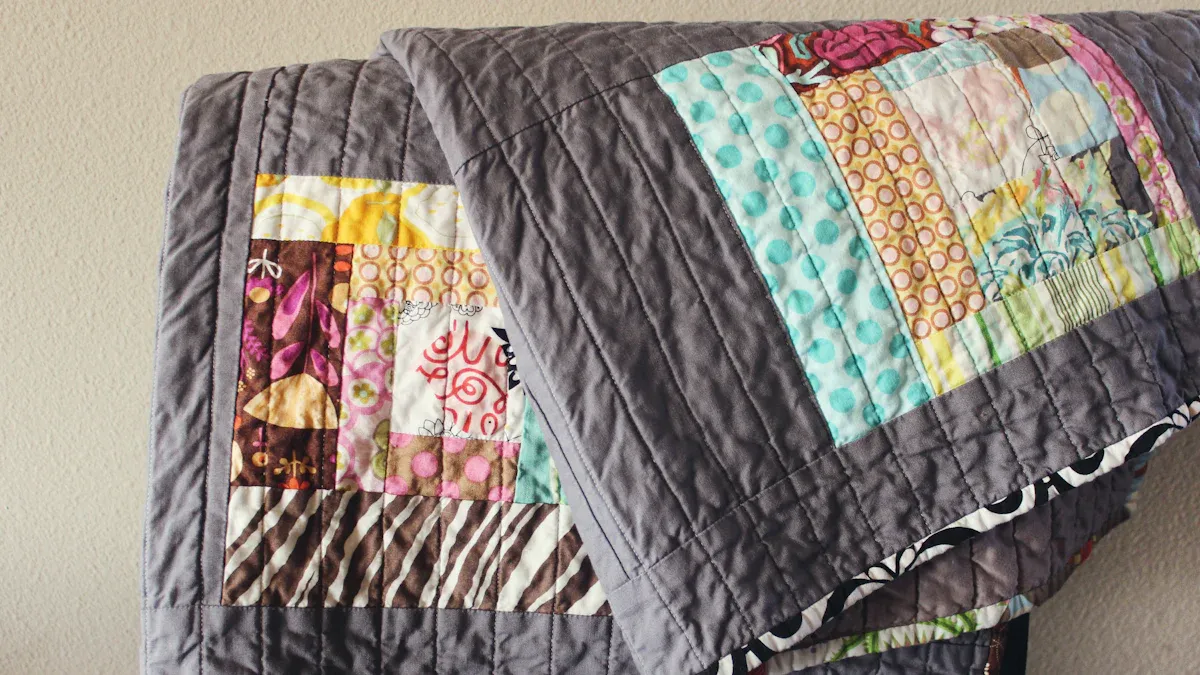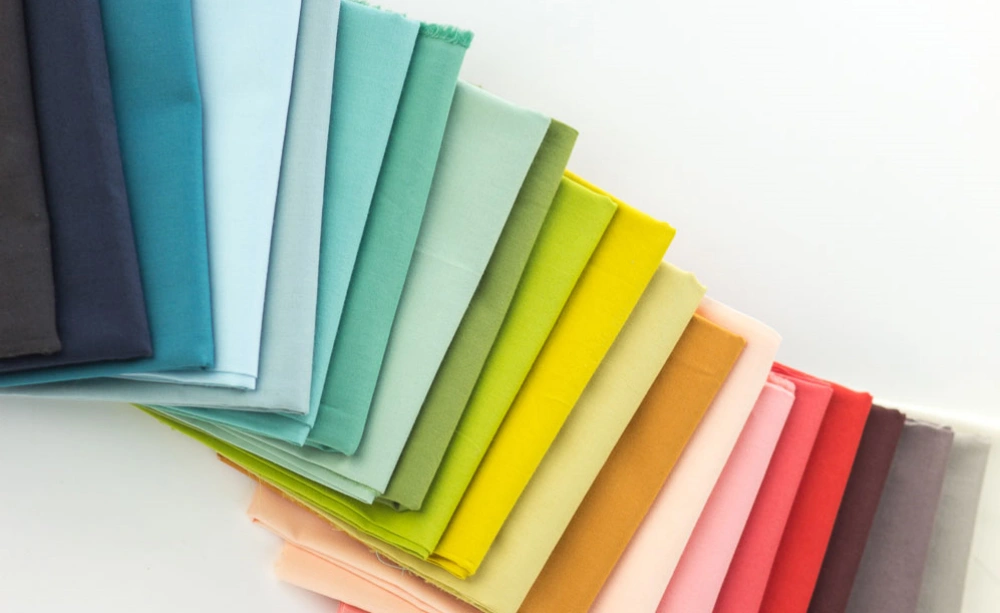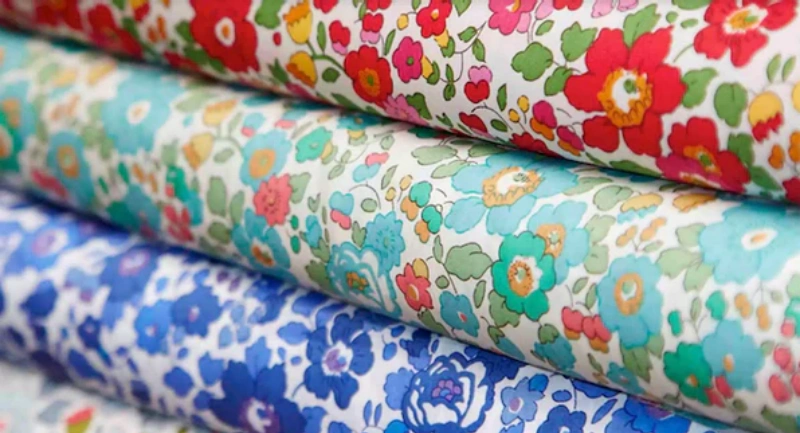
If you’re wondering, is cotton poplin good for quilting, you’re not alone. Many quilters love its crisp texture and vibrant prints, which can add a modern touch to your quilting project. You might notice poplin’s smooth finish makes piecing easy, but it can feel a bit stiff for intricate handwork.
Fanda Fabrics offers high-quality cotton poplin and quilting fabrics, so you can find the right material for your next creative adventure. Is cotton poplin good for quilting? It depends on your style and what you want from your quilt.
Key Takeaways
Cotton poplin works well for quilting projects that need sharp lines, bold colors, and a modern look.
Poplin is strong, durable, and holds its shape, making quilts last longer and look polished.
Prewash poplin before cutting to prevent shrinking and avoid surprises after washing.
Poplin can be stiff, so it’s best for straight seams and machine quilting rather than curved or hand quilting.
Fanda Fabrics offers high-quality cotton poplin and quilting cotton, giving you many options for your projects.
Is Cotton Poplin Good for Quilting?
Quick Answer
If you’re searching for a straight answer to “is cotton poplin good for quilting,” here it is: Yes, you can use cotton poplin for quilting, but it works best for certain styles and techniques. Poplin’s crisp, smooth texture gives your quilt a modern look with sharp lines and vibrant prints.
You’ll find it especially useful if you love bold geometric patterns or want your quilt blocks to look extra sharp. However, poplin feels a bit stiffer than traditional quilting cotton, so it may not be the best choice for every project.
You can always find premium cotton poplin at Fanda Fabrics, where quality and variety make it easy to match your creative vision.
Main Pros and Cons
When you ask, “is cotton poplin good for quilting,” you probably want to know what makes it stand out—and where it might fall short. Here’s a quick breakdown to help you decide:
Pros:
Poplin has a dense, crisp weave that holds its shape well. You get clean, straight lines in your quilt blocks.
The fabric absorbs dyes and prints beautifully, so your quilt can feature bold, vibrant colors and detailed patterns.
Cotton poplin is strong and durable. It stands up to repeated washing and daily use, making your finished quilt last longer.
The smooth surface feels soft and comfortable, which makes handling and sewing easier.
You can use poplin for both machine quilting and embroidery, thanks to its sturdy yet supple feel.
Cons:
Poplin’s stiffness can make it tricky for curved piecing or intricate hand quilting. If you love soft, drapey quilts, you might find poplin a bit too crisp.
The fabric doesn’t blend seamlessly with traditional quilting cotton. Mixing the two can lead to differences in texture and shrinkage.
Poplin tends to wrinkle and shrink unless you pre-wash it. You’ll want to wash and dry your fabric before starting your project to avoid surprises later.
While poplin is breathable, it doesn’t offer the same warmth and loft as classic quilting cotton, so your quilt may feel lighter and less puffy.
Tip: If you want to use poplin in your quilt, try pairing it with other poplin fabrics for a consistent look and feel. Always pre-wash your fabric to prevent uneven shrinkage.
So, is cotton poplin good for quilting? It depends on your style and what you want from your quilt. If you love crisp lines, bold colors, and modern designs, poplin could be a great fit.
For a softer, cozier quilt, you might prefer traditional quilting cotton. Fanda Fabrics offers both options, so you can choose what works best for your next project.
Poplin Features for Quilting
Texture and Weight
When you pick up cotton poplin, you’ll notice its unique texture right away. The fabric feels smooth and crisp, thanks to its plain weave and fine, horizontal ribs. This texture helps you press seams flat and get sharp, clean lines in your quilt blocks.
Poplin is a high-quality medium-weight cotton, so it feels sturdy but not bulky. You get a fabric that holds its shape well, making it perfect for modern quilts with bold patterns. The higher thread count—usually between 100 and 120 threads per inch—means poplin is denser and more structured than regular quilting cotton.
If you want your quilt to look neat and polished, this medium-weight cotton gives you that edge.
Durability and Care
You want your quilt to last, and cotton poplin delivers on durability. The tight weave makes this fabric strong and resistant to tearing or fraying, even after lots of handling. Poplin holds up well through repeated washing, keeping its crisp look and vibrant colors. Here’s a quick look at how poplin compares to quilting cotton:
Feature | Cotton Poplin | Quilting Cotton |
|---|---|---|
Durability | Very durable, dense weave | Durable, but softer drape |
Shrinkage after wash | Less shrinkage, holds shape | May shrink more |
Shape retention | Stays crisp and structured | Softer, less structured |
Color retention | Keeps color with proper care | Keeps color with proper care |
To keep your poplin quilt looking its best, follow these steps:
Wash in cold or lukewarm water.
Use a gentle cycle and mild detergent.
Air dry or tumble dry on low heat.
Iron on a warm setting to keep that crisp texture.
Fanda Fabrics Cotton Poplin
Fanda Fabrics offers cotton poplin that stands out for quilting. You get 100% cotton with a smooth, soft feel and a subtle sheen. The fabric breathes well, so your finished quilt feels comfortable in any season. Fanda Fabrics’ poplin absorbs dyes beautifully, giving you access to vibrant colors and detailed prints for your projects.
You can choose from a range of weights, colors, and finishes, making it easy to match your creative vision. Specialty treatments like water resistance or fire retardancy are available, along with certifications such as Oeko-Tex and GOTS.
With Fanda Fabrics, you get fabric that’s easy to cut, sew, and care for—making your quilting experience smooth from start to finish.
Quilting Cotton vs Poplin

Weave and Feel
When you pick up quilting cotton and cotton poplin, you’ll notice some clear differences. Quilting cotton has a thicker, more robust feel. It’s made from shorter cotton fibers, which gives it a sturdy hand and a bit of stiffness. This makes it perfect for quilts that need structure and warmth.
Cotton poplin, on the other hand, uses a plain weave with thicker weft yarns, creating a subtle ribbed texture. Poplin feels lighter and smoother, almost crisp, but not as heavy as quilting cotton.
Some quilters say poplin can feel a bit flimsier, but its tight weave helps it hold sharp lines and shapes. If you run your hand over both, you’ll find quilting cotton feels more substantial, while poplin feels sleek and cool.
Performance in Quilting
You might wonder how these two fabrics perform when you start quilting. Quilting cotton shines in traditional quilts. Its weight and sturdiness make it easy to cut, piece, and sew. It holds up well to repeated washing and daily use.
Cotton poplin, with its crispness and tight weave, is great for projects that need sharp seams and precise shapes. You’ll find poplin less likely to fray, which makes it easier to handle for detailed piecing. However, poplin’s lighter weight means it won’t give your quilt the same cozy, puffy feel as quilting cotton.
If you love modern, structured designs, poplin is a solid choice. For classic, soft quilts, quilting cotton remains the favorite.
Mixing Fabrics
Mixing cotton poplin with quilting cotton in one quilt can be fun, but you’ll want to plan ahead. Different fabrics can shrink at different rates, so always prewash everything before you start cutting. This step helps prevent distortion after your first wash.
Poplin’s tight weave means it resists fraying, but you should still use sharp needles and finish your seams neatly. Some quilters enjoy combining different types of quilting cotton and poplin for texture and visual interest.
Just remember, matching the weight and feel of your fabrics will help your quilt look and feel its best. Fanda Fabrics offers both quilting cotton and cotton poplin, so you can experiment and find what works for your style.
Pros of Cotton Poplin in Quilting
Crisp Lines and Structure
When you want your quilt blocks to look sharp and modern, cotton poplin shines. This fabric feels denser and crisper than most quilting cotton. You’ll notice a subtle ribbed texture that helps your seams stay flat and your lines look clean.
If you love bold geometric designs or want your quilt to have a structured appearance, poplin is a great choice. Here’s why so many quilters reach for it:
The tight plain weave with thicker weft yarns gives poplin a crisp, paper-like feel.
It holds pleats and structured details well, so your quilt blocks keep their shape.
Poplin resists wrinkles better than many other cotton fabrics.
You get sharp, defined edges that make your quilt look polished and professional.
Tip: If you want the best results, try using poplin for straight-line piecing or modern quilt patterns. You’ll see those crisp lines pop!
Vibrant Colors and Prints
You probably want your quilt to stand out with bright colors and eye-catching prints. Cotton poplin makes this easy. The fabric absorbs dyes beautifully and keeps its color, even after many washes. You’ll find poplin in a huge range of trendy prints and bold shades. This means your finished quilt will look fresh and vibrant for years.
Poplin’s smooth surface also helps prints look sharp and detailed. If you love working with fun patterns or want your quilt to make a statement, poplin gives you plenty of options.
Versatility in Quilt Styles
Cotton poplin isn’t just about structure and color. It’s also a versatile fabric that works for many quilting styles. The lightweight, durable, and breathable qualities make it easy to handle. You can use poplin for everything from wall hangings to bed quilts. Its smooth texture and crisp hand-feel give your projects a polished look.
You’ll also find poplin blends that add even more versatility. These blends combine cotton’s comfort with extra durability and wrinkle resistance. This means you can try new techniques and styles without worrying about your fabric letting you down.
Note: Fanda Fabrics offers a wide selection of cotton poplin in different colors, prints, and finishes. You can match your fabric to any quilting project you dream up.
Cons of Cotton Poplin in Quilting
Hand Quilting Challenges
If you love hand quilting, you might notice that cotton poplin brings a few extra challenges. The fabric feels thinner than regular quilting cotton, so you need to use more basting to keep everything in place.
When you quilt by hand, you should slow down. Stitching too fast can cause tension problems or even a “push and pull” effect that distorts your work. Picking the right needle matters, too. Finer needles, like a 70/10, help prevent large holes in the fabric.
The tight weave of poplin makes it harder for the needle to pass through, which can affect your thread tension. Washing and starching the fabric before you start can make it easier to handle. Poplin doesn’t stretch much across the grain, so piecing straight lines is easier, but curves can be tricky.
Tip: Take your time and use extra basting when hand quilting with poplin. This helps keep your layers smooth and even.
Curves and Appliqué
Working with curves or appliqué in patchwork and quilting can be more difficult when you use cotton poplin. The crisp, structured feel that makes poplin great for straight lines can make it less flexible for curved seams.
You might find it harder to ease the fabric around tight corners or create smooth, rounded shapes. Appliqué pieces may not lie as flat or blend as well into the quilt top. If you want to try detailed appliqué or lots of curves, you may need to use extra pins, clips, or even a bit of starch to help the fabric behave.
Mixing with Other Cottons
Mixing cotton poplin with other types of cotton in your quilting projects can lead to a few issues. Poplin has a higher thread count and feels crisper and stiffer than most quilting cotton. This difference can affect the overall feel and flexibility of your finished quilt.
Poplin also wrinkles more easily and shows those wrinkles more, which can change the look of your quilt after washing. The biggest challenge comes from the different shrinkage rates. If you don’t prewash all your fabrics, you might see puckering or uneven texture after your first wash.
Here are some things to keep in mind when mixing poplin with other cottons:
Prewash all your fabrics before cutting and sewing to prevent shrinkage surprises.
Handle the edges of poplin carefully, since it can fray more than standard quilting cotton.
Consider lining poplin pieces to reduce stiffness and improve comfort in your quilt.
Note: Paying attention to these details helps your quilt look and feel its best, even when you mix different cotton fabrics.
Quilting Tips with Fanda Fabrics Poplin

Cutting and Piecing
Getting clean, accurate cuts is key when you work with Fanda Fabrics’ cotton poplin. Start by prewashing your fabric to prevent shrinkage and color bleeding. Once dry, press and square the fabric so it lies flat. Use a sharp rotary cutter and an acrylic ruler with grid lines for straight, precise cuts. Always cut along the grain to keep your pieces stable.
If you love foundation paper piecing, poplin is a great choice. Cut your fabric pieces about a quarter to three-quarters of an inch larger than your pattern sections. This gives you room for seam allowances and trimming. Hold your ruler firmly and cut slowly to avoid shifting.
For intricate designs, use sharp needles and press seams carefully. You might want to use adhesive grips on your ruler for extra stability.
Tip: A self-healing cutting mat keeps your blades sharp and protects your work surface.
Prewashing and Care
Cotton poplin needs a little extra attention before you start quilting. Always prewash your fabric to control shrinkage and set the colors. Use a mild, fragrance-free detergent and wash on a gentle cycle with cold water. Adding a bit of table salt or white vinegar can help set the dye and prevent bleeding.
After washing, remove the fabric promptly and dry on low heat or air dry flat. Press the fabric before cutting to keep it crisp and smooth. If you notice any fraying, finish the raw edges with a zigzag stitch before washing.
Note: Test a small swatch first if you’re worried about colorfastness or shrinkage.
When to Use Poplin?
You’ll find cotton poplin especially useful for quilting projects that need a crisp, modern look. Its dense weave and ability to hold shape make it perfect for geometric quilts, lap quilts, and wall hangings. Poplin’s vibrant prints and sharp lines shine in projects where you want bold color and structure.
If you’re making a whole cloth quilt or a piece that will hang on the wall, poplin gives you that clean, professional finish. For cozy, hand-quilted throws, you might prefer a softer cotton, but for anything that needs durability and a polished look, poplin is a fantastic choice.
Project Type | Why Poplin Works Well |
|---|---|
Modern quilts | Crisp lines, bold colors |
Lap quilts | Holds shape, durable |
Wall hangings | Structured, professional appearance |
Whole cloth quilts | Smooth surface, vibrant prints |
Best Cotton for Quilting Projects
Choosing the Right Fabric
Picking the best cotton for quilting can feel overwhelming with so many choices out there. You want your quilt to look great, last long, and feel just right. Here are some things you should think about before you start your next project:
Look at the type of cotton. Quilting cotton is a classic pick. It’s medium weight, tightly woven, and easy to handle. Cotton poplin is denser and crisper, which works well for modern or geometric quilts. Cotton lawn feels silky and light, perfect for delicate or vintage-style quilts, but it can be slippery.
Check the fabric’s weight and weave. Heavier cottons give your quilt more structure, while lighter ones make it softer and drapier.
Think about the texture and print. Smooth fabrics look sleek and modern. Textured ones add a rustic touch. Make sure the print size matches your quilt design.
Consider how you’ll use the quilt. Baby quilts need soft, hypoallergenic cotton. Heirloom quilts do best with high-thread-count, durable fabric.
Match your skill level. Beginners usually find quilting cotton easiest to work with. If you’re more advanced, you might want to try poplin or specialty cottons.
Always prewash your fabric. This step helps prevent shrinkage and color bleeding later.
Don’t forget your budget. You can mix premium and affordable fabrics to save money without losing quality.
Tip: Mixing different cottons is possible, but pay attention to shrinkage and drape. Prewashing and using stabilizers can help your quilt turn out just right.
Fanda Fabrics Options
Fanda Fabrics makes it easy to find the right cotton for any quilting project. You can choose from a wide range of 100% cotton poplin, which comes in weights from 115 to 150 GSM and a standard width of 145 cm.
The poplin features digital printing, so you get sharp, vibrant designs every time. It’s soft, lightweight, and durable—great for quilts, home decor, or even apparel.
If you prefer traditional quilting cotton, Fanda Fabrics offers it in all the popular formats: Fat Quarters, Jelly Rolls, Mini Charm Packs, Charm Packs, and Layer Cakes.
These pre-cut options let you mix and match colors and prints with ease. You’ll find everything from small repeating prints to bold patterns, so your quilt can be as simple or as intricate as you like.
Feature | Details |
|---|---|
Composition | 100% cotton poplin |
Weight | 115-150 GSM |
Width | 145 cm |
Printing Style | Digital Printing |
Fabric Qualities | Soft, lightweight, durable |
Suitable Uses | Quilting, home decor, apparel |
You can also order custom fabrics or buy in bulk, which is perfect if you want something unique or need a lot of material. Fanda Fabrics supports both small and large orders, so you always get what you need for your quilting adventure.
Conclusion
You’ve seen that cotton poplin brings crisp lines, vibrant prints, and durability to your quilting projects. It feels more structured than cotton lawn and lacks that silky drape, so it works best for quilts where you want sharp shapes and a modern look.
Some experts say poplin is great for sewing and easy to handle, but it’s not as soft as other fabrics. Think about what you want from your quilt. If you love structure and bold color, poplin is a smart pick. For both cotton poplin and classic quilting cotton, Fanda Fabrics has you covered.
FAQ
What is cotton poplin best used for in quilting?
You’ll love cotton poplin for modern quilts, wall hangings, and projects that need crisp lines. It works great for geometric patterns and bold prints. If you want a quilt with a sharp, polished look, poplin is a smart pick.
Can I mix cotton poplin with other quilting fabrics?
You can mix poplin with other cottons, but always prewash everything first. Poplin and quilting cotton shrink differently. Prewashing helps your quilt stay smooth and prevents puckering later.
Does cotton poplin shrink after washing?
Yes, cotton poplin can shrink a bit, especially on the first wash. Always prewash your fabric before you start cutting or sewing. This step keeps your finished quilt the right size.
Is cotton poplin easy to sew for beginners?
Absolutely! Poplin’s smooth surface and stable weave make it easy to cut and sew. You’ll find it less likely to fray, so it’s a good choice if you’re just starting out.
How do I care for a quilt made with cotton poplin?
Wash your quilt in cold or lukewarm water on a gentle cycle. Use mild detergent. Air dry or tumble dry on low. Iron on a warm setting if you want to keep that crisp look. Your quilt will stay vibrant and fresh!
